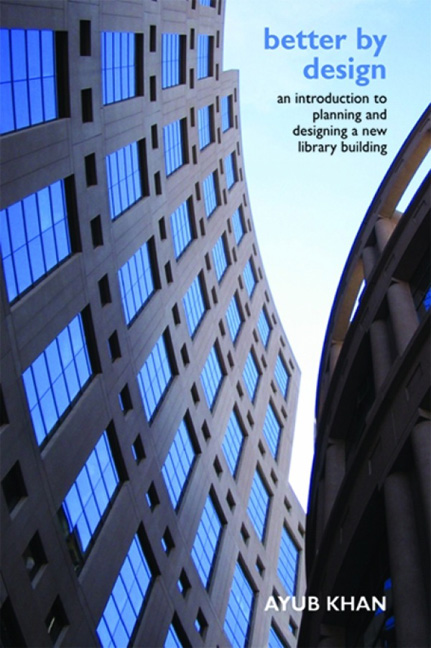Book contents
- Frontmatter
- Dedication
- Contents
- Lists of figures and tables
- Preface
- Acknowledgements
- Abbreviations and technical terms
- 1 Introduction
- 2 21st-century libraries
- 3 Developing a business case
- 4 Project management
- 5 The design/project team
- 6 Selecting an architect
- 7 Partnership and community engagement
- 8 The design brief
- 9 Design quality
- 10 Space planning and access
- 11 Occupancy and post-occupancy evaluation
- 12 Building libraries for the future – a summary
- Bibliography and further reading
- Appendices
- Index
- Miscellaneous Endmatter
- Miscellaneous Endmatter
- Miscellaneous Endmatter
- Miscellaneous Endmatter
- Frontmatter
- Dedication
- Contents
- Lists of figures and tables
- Preface
- Acknowledgements
- Abbreviations and technical terms
- 1 Introduction
- 2 21st-century libraries
- 3 Developing a business case
- 4 Project management
- 5 The design/project team
- 6 Selecting an architect
- 7 Partnership and community engagement
- 8 The design brief
- 9 Design quality
- 10 Space planning and access
- 11 Occupancy and post-occupancy evaluation
- 12 Building libraries for the future – a summary
- Bibliography and further reading
- Appendices
- Index
- Miscellaneous Endmatter
- Miscellaneous Endmatter
- Miscellaneous Endmatter
- Miscellaneous Endmatter
Summary
First we shape our buildings and afterwards our buildings shape us.
(Winston Churchill, 24 November 1951)The design of a library profoundly affects the experience of its users, in exactly the way the quotation above suggests. The design will set the tone for the environment and the ethos of the facility and will contribute to the total library experience of all users and staff. Physical spaces are changing as a result of new technologies, and student-centred approaches to learning have led to a need to rethink library design.
However, libraries of the 21st century are no longer simply repositories for print-based materials and books. They have changed and expanded, been rethought and redesigned. Libraries now provide an increasing range of services and facilities, using a multitude of media to reach a more diverse audience than ever before.
The developing role of the library has created a set of new and complex challenges for those delivering library buildings and services. There is no such thing as the ‘perfect’ library building. However, a well designed building may enable a project both to gain local acceptance more easily and to ease the process of securing planning permission. It should also support the parent organization well and offer a better service to users than the building it may replace. It should be more efficient to run than any former building and be easily adaptable to a different use if no longer required. The process of creating a new library is therefore one of the most complex, challenging and fulfilling activities that an individual or organization can undertake.
Although the word ‘library’ is used, and this continues to have a strong brand, a number of institutions have chosen to use a different word for their buildings. Examples include: learning resource centre, learning hub, information centre, learning mall, knowledge place, multimedia centre, ideas store, book bar, cultural centre or some kind of ‘forum’. The term ‘library’ in this book could denote all of the above.
This book aims to steer a path for library practitioners through the planning of new library buildings and facilities. It is meant for beginners, not only for people new to the library profession but also for skilled and experienced practitioners who are approaching for the first time the important task of creating a new library or major refurbishment or remodelling of existing facilities.
Information
- Type
- Chapter
- Information
- Better by Designan introduction to planning and designing a new library building, pp. xiii - xivPublisher: FacetPrint publication year: 2008
